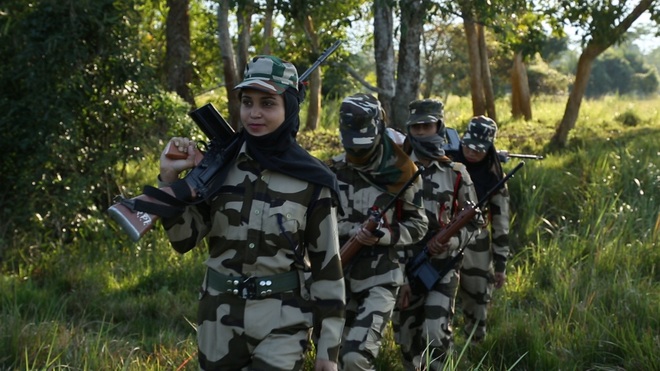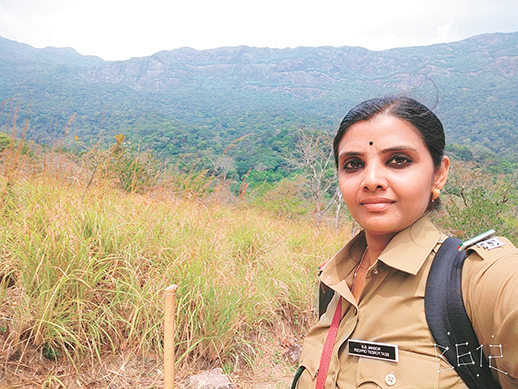
Kavita Kanan Chandra
It’s not for the faint-hearted to walk around the rugged wilderness, putting your life and limb at risk on a daily basis. Dangers might be lurking everywhere, from wild animals to bullets of poachers.

Pacifying angry villagers when wild animals stray in their farms to confronting illegal felling of trees needs immense patience and tact. The forest guards are rightly the green soldiers in the frontline of India’s wildlife, and the onus of wildlife conservation pretty much falls on them.
With the recruitment of women forest guards over the years, the protection and conservation efforts have only scaled up. They can better deal with village women resorting to some illegal activities inside the forest area than male guards can.
Though there were women forest officers, women forest guards were unheard of till the Gujarat Forest Department recruited its first batch of 43 women in 2007. It was then Chief Minister Narendra Modi who provided 33 per cent reservation for women in forest guards’ appointment.

Other states followed, with Assam in 2010 recruiting 34 women. The most recent recruitment was in Bihar this year. In 2018, in Kerala, 40 out of 113 forest guard trainees were women. Last year, Tamil Nadu made news with the first-ever mass recruitment of 190 women forest guards.
In Sunderbans, women have gone door-to-door spreading awareness about the conservation of mangroves, so important for wildlife
Tamil Nadu has recently created an Elite Forest Force having two women and 12 men. With high-tech training in GPS mapping, rescue of wildlife in distress, martial arts and riding all-terrain bikes, it’s a tough force. Last year, in Assam, a much-required Special Rhino Protection Force was created comprising 82 constables, eight of them women. With an aim to check the poaching of the one-horned rhinoceros, they have been given weapons training. Being considered for the toughest of forest duties, women have come a long way. A woman sums up by saying they didn’t join as women forest guards, but as forest guards.

Tales of fortitude
One of the very first women forest guards in India, Rasila Wadher of Gir National Park in Gujarat recalls her animal rescue operations. Once a leopard fell in a newly dug well and all efforts to tranquilise failed. Rasila volunteered to be lowered in a cage and ignoring the leopard’s growls, managed to make it unconscious. The leopard was hauled up in harness and later released in the forest. Her courage and fortitude won her respect from fellow guards. The women forest guards of Gir are aptly termed ‘lionesses’ as each one of them has a story to tell about rescue and conservation.
Forest guard Geeta and Range Forest Officer Jyoti Vaja have been on field duty for long. Geeta remembers the gruelling days and nights when they were chasing a wild animal through villages and finally rescued it.
Being considered for challenging duties, women have come a long way. one of them sums up: ‘We didn’t join as women guards, but as guards’
The courage shown by a 28-woman team of the Special Tiger Protection Force (STPF) in Pench National Park (Madhya Pradesh) and Tadoba-Andhari Tiger Reserve in Maharashtra is exemplary. Felicitated by ‘Sanctuary’ magazine in 2014, the team was credited for anti-poaching efforts. Patrolling the entire forest in batches 24x7, they ensured that the poachers did not poison the waterholes, set traps or shoot the tigers. They had often run into poachers, but dealt with them bravely.
Barring a few recruits assigned for special duties, most forest guards just have a lathi at their disposal. They must be alert, physically and mentally strong and willing to take risks. When Sudha Dhurve of Satpura Tiger Reserve was on foot with two other male guards following a tiger pugmark, little did she know of an encounter with a tiger 10 metres away. From going numb to alerting her co-guards, she showed her presence of mind to stay put and not budge. It was a face-off they endured for an hour-and-a-half, sweating profusely in cold winter. Fortuitously, the striped cat backed off and they lived to tell the tale.
The decisions should be quick, whether they are saving themselves, rescuing animals or averting a commotion. When Aarti Hirpara was once patrolling in Gir on her motorbike, she saw a pride of lions heading towards the road that goes through Gir. “I parked my bike by the roadside and sat with my back to the lions, looking the other way for four hours. The commuters looked that way and finding no lions, sped past me,” said Aarti. The lions rested there and crossed the road only after dusk. She feels they sense their protectors.
Eyes and ears of parks
The 1,412 square km of Sasan-Gir is the last remaining natural habitat of 523 Asiatic lions, listed as endangered by IUCN (International Union for Conservation of Nature), thanks to the local Maldhari community, who have farms in proximity of Gir but co-exist in harmony with the wild beasts.
The one-horned rhinoceros of Kaziranga National Park have no such luck; poaching has always been an issue, and animals also get hit by vehicles as NH 37 passes through the park. The Special Rhino Protection Force (SRPF) was specifically formed in July 2019 to tackle the poaching menace, especially of the highly vulnerable one-horned Indian rhinoceros (rhinoceros unicornis) that is listed in the Red List of threatened species by the IUCN. It is prized for its horns, which is used in Chinese medicines and as an aphrodisiac, fetching lakhs of rupees in the international market.
The SRPF team comprising 74 men and eight women is armed with guns and has undergone tough training. Many are employed in Kaziranga and are the eyes and ears of the park, protecting 2,413 rhinos. “There have not been any poaching incidents since we joined,” says Uma Baruah, an SRPF member. The locals who were suspected of sheltering poachers are now fearsome and the SRPF also engages more with the local Karbi community.
In the barren Desert National Park at Sudasari in Rajasthan, home to the endangered Great Indian Bustards (GIB), Sukhpali recalls her early days as the state’s first female guard in 2013. The vast stretches of sand, shrubs and bushes appeared daunting to traverse, with extremes of winter and summer temperature. “It used to be a bit lonely, at times walking for hours in barren desert, but I fell in love with the solitude of the forest,” says Sukhpali. “Our daily routine included monitoring the water holes in the parched desert, keeping local interference at bay as villagers let loose their cattle inside and monitoring the GIB,” adds Pushpa Kanwar.

Roshni, a Beat Forest Officer (BFO) deployed in the Puruthippally forest range in Kerala, shares the sentiments and feels secure in the forest area and happy to protect it. In a forest with sambars, elephants, deer and wild boars, they do have close encounters, especially with the latter. During night patrolling, any mishap is averted as they flash their torches on wild animals and they go. “We have our little torches, but better safety equipment and lights would give us more confidence,” says Roshni.
High altitude, dense forest, grasslands to the swamps of mangrove forests, women guards are up for conservation. In the Sunderbans, they have also gone door-to-door, spreading awareness about the conservation of mangroves, so important for wildlife survival.
During heavy rains in monsoon in Kaziranga, being drowned or poaching is a real possibility. The forest guards and SRPF prod the rhinos and big animals and take them to 140 artificial highlands, “where we keep vigil be it day or night, cold or rain”, says Uma Baruah. She confidently brushes aside any notion of fear, convinced that the animals have a strong instinct of who is a friend.
The sentiment is echoed by women forest guards across India as well as their male counterparts. Together they defend, protect and conserve the country’s forest wealth and environment.
Join Whatsapp Channel of The Tribune for latest updates.



























